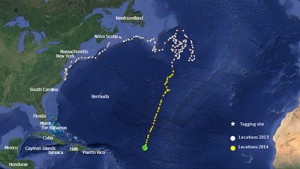
OCEAN CITY — Scientists and shark enthusiasts are keeping a close eye on the suddenly directed movements of a juvenile shortfin mako shark tagged last summer off the coast of Ocean City, which, after meandering around the north Atlantic for several months, is now heading directly south without wavering from its course.
Last summer, a juvenile shortfin mako shark was tagged off the coast of Ocean City and its movements have been tracked since by researchers and scientists at the Guy Harvey Research Institute (GHRI) at the Nova Southeastern University and the Save our Seas Research Center. The GHRI team has been tracking several species tagged with satellite-lined devices in order to gain a better understanding of the movements and migration patterns of the threatened sharks and one in particular is gaining special attention after taking a decidedly distinct track in the last month or so.
The mako tagged off the coast of Ocean City in July, referred to by Nova and the GHRI team as I-NSU, meandered around the north Atlantic staying largely close to the coast for much of the late summer and fall. For several weeks, I-NSU wandered aimlessly around the north Atlantic off the coast of Nova Scotia and Newfoundland.
About a month ago, however, I-NSU started headed south in virtually a straight line through the western Atlantic and has not wavered from its path.
“I’ve never seen one act quite like this one,” said Dr. Mahmood Shivji, director of the GHRI and Save our Seas Research Center this week. “The mako is displaying an amazingly directed movement, as if this shark has a specific destination it wants to get to in a hurry.”
The GHRI and Save our Seas began tagging makos in 2009. The research programs are currently monitoring as many as 16 makos with a particular interest in mako shark behavior and conservation under increased fishing pressure. For example, three of the nine makos tagged in 2013 have already been snared in commercial long-line fisheries. However, I-NSU is swimming freely in the Atlantic and its latest track is raising eyebrows.
“I-NSU showed an irregular and looping pattern for four months when it was exploring northern latitudes, but at some point, it decided it was time to get somewhere directly south and has been on a virtual straight track for the last nearly 1,100 miles,” said Shivji.
